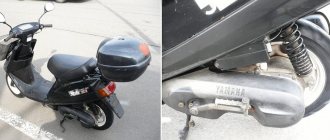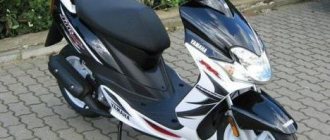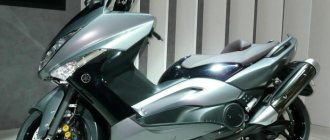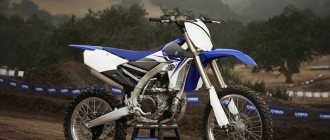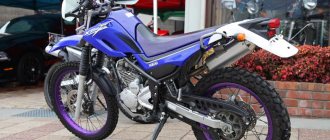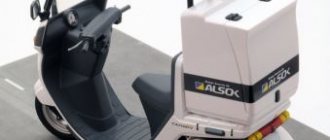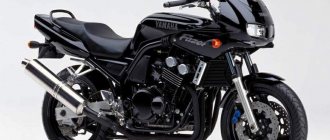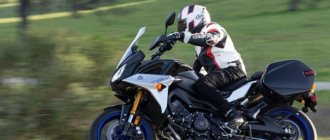In 2003, not only Japanese 50 cc scooters, but also 125 cc scooters successfully debuted in European markets Cygnus X 125. The success was predictable, since the scooter manufacturer - Yamaha Motor Company, has held a leading position in the motorcycle market since 1955. Buyers, after reviewing scooters, often stop their attention on the X 125 model. Indeed, this scooter is one of the best models of a city scooter in the 125 cc class. It is as maneuverable as a 50 cc scooter, and as dynamic as a 125 cc scooter. The wheelbase is small - only 1295 mm, so the scooter can easily overcome city traffic jams.
Cygnus typically delivers a scooter consumption of 3 liters per 100 km during a quiet ride. During vigorous driving, in accordance with the passport characteristics, its consumption is 4 liters per 100 km. According to reviews from scooter owners, acceleration cannot be called dynamic. The response characteristics of the X 125 scooters are satisfactory - they correspond to the cruiser class.
Yamaha Motor regularly evaluates the failure statistics of its equipment. If a review of scooters reveals unstable operation of the units, then such models are recalled and modified. For example, this happened with the XC125 modification, in which unstable operation of the speedometers was detected. This fact allows us to say that Yamaha Motor is a company that produces reliable motorcycles.
The Cygnus X 125 uses high-quality materials in its design. In addition, all modern technologies are provided to increase the comfort of the driver and passenger: a wide stepped seat, a trunk under the seat, an open glove box. It should be noted that the braking is uniform, backed up by brake lights, and the suspension is comfortable. The luminosity of the headlights is quite sufficient for driving through the city at night. The scooter has sufficient ground clearance for driving on country roads.
Specifications
The engine data and other characteristics are successfully combined with a stylish and modern design, so the scooter rightfully deserves to be a competitor to more well-known models up to 200 cubic meters of power. It is also worth noting that the Yamaha Majesty scooter has several models of different power in its lineup; there are a number of models with 125, 150, 180, 250 and even 400 cubic meters. Particular attention should be paid to the engine characteristics of the 125 cc model. With this volume, 1 cylinder is installed, work is carried out in 4-stroke mode. 2 valves are installed, for the Japanese this is an excellent solution to ensure good traction and high maximum speed. The gas distribution system assumes the presence of a camshaft in the cylinder head; a feature of the model is the presence of water cooling. And just imagine this, in a seemingly ordinary 125 cc scooter!
As a result, all the above characteristics made it possible to produce a power of 11 horsepower and the ability to accelerate to 105 km/h. The torque indicator was 23 Nm. Japanese quality has yielded results, despite the long life of the scooter, most of its parts are still standard. Being a real maxi scooter, you can buy a Yamaha Majesty 125 with a good weight of 125 kg. Good tires with a diameter of 12 inches are installed. The length was 2021 mm, which only improves comfort when moving and makes it possible for two people to travel on long trips.
Test drive Yamaha Cygnus RS 125
Yamaha has been doing great in the budget motorcycle market for a long time. Its perennial bestseller, the Yamaha YBR-125, remains a favorite among people just starting out in the motorcycle life. Apparently, such success was not enough for Yamaha, and it decided to conquer the budget scooter market at all costs. Starting this year, a new Yamaha Cygnus RS 125 scooter has appeared in its showrooms, which, despite its cubic capacity, costs one and a half times less than some of its 50 cc brothers. Such a low price can only be explained by the fact that this scooter is entirely manufactured in China. But against the background of the attractive appearance of the scooter and the same attractive price, this no longer seems to be a significant drawback. Moreover, the same YBR-125 has gained fame as a reliable and unpretentious motorcycle. After all, if the equipment is produced under the Yamaha brand, this already means a lot.
But enough of the introductions, because it’s too early to talk about the future of this scooter, since we are just beginning to get acquainted with it. First impressions of the scooter: it looks much more attractive in person than in the pictures on the Internet. Despite its simple shape and trivial technical solutions, the scooter compares favorably with other “indigenous Chinese” due to its high quality of manufacturing, fitting and painting of plastic parts. I can assume that everything inside was done just as neatly as outside, because during the entire test, nothing rattled, knocked, or even creaked anywhere. At the same time, during the test we tried to test the scooter’s suspension not only on smooth asphalt, but also on typical broken Kyiv roads.
While our photographer was trying to capture the scooter in all its glory, we had time to look at it in detail (the scooter, not the photographer)... The four-stroke air-cooled engine is clearly not designed to break any records, especially since it only has 8.2 hp and 8.4 Nm of torque. This is only slightly better than typical two-stroke Japanese "fifty dollars", the engine of which often produces 7-7.5 hp. But due to the higher torque, the Cygnus RS is able to provide better traction, but not maximum speed. This scooter is still equipped with a carburetor, and the engine can be started not only by an electric starter, but also by a kick starter. In addition, servicing such equipment at home will be much easier than if equipped with an injection power system.
As standard, the scooter is equipped only with a central stand, although a mount for a side support was initially welded to the frame, but for some reason the latter is missing. The reason is quite simple. The Yamaha company, in the same body, produces a slightly more progressive scooter called Vity with an injection engine and a richer package, which includes that same side stand. But Vity, of course, costs more.
There is a decent-sized trunk under the seat, but, unfortunately, it does not fit an integral helmet. It almost fits, but the trunk is only about three centimeters deep enough to close the seat. But the standard equipment of the Cygnus includes a metal trunk, which is capable of carrying up to 10 kg of luggage, which means that not only a small, but also a medium-sized case of 40-45 liters can be attached to the scooter, which can fit not one, but even two integrals.
The device is relatively compact, and can easily pass for a “half ruble”, only the solid bass sound of the engine gives it away as a “cubature”. Thanks to the low seat, both legs can freely reach the ground, and therefore it is very easy to maneuver the scooter at low speeds and make your way through dense traffic.
In addition, the scooter has a huge steering wheel, which allows you to literally turn around on the spot and squeeze into almost any gap between cars stuck in a traffic jam. Only because of the same compactness of the scooter, with a large turn of the steering wheel, it rests on one or the other knee, and therefore the interfering leg has to be placed on the ground.
Even at the inspection stage, I noticed that the front disc brake is equipped with only a single-piston caliper. Then it seemed to me not enough. Imagine my surprise when, when I pressed the front brake lever, the scooter began to slow down sharply. So, in relation to the Cygnus 125 RS, the old Russian proverb is quite appropriate: “They are greeted by their clothes, they are seen off by their minds!” After all, it turns out that not everything in Cygnus RS is as simple as it seems at first glance. Even the rear drum brake copes with the functions assigned to it 100%. And the tires, despite the fact that it’s early spring outside and the thermometer shows only +6, hold the road perfectly. If you wish, you can even make a stoppie on this “stool”, although I would not recommend this to anyone. After all, despite the RS prefix in the name, Cygnus is not a sports car and is not very suitable for extreme driving. However, it all depends on what you mean by extreme driving...
It does not handle sharp accelerations well - the engine pulls confidently, even uphill, but the variator is tuned for a quiet ride. The start occurs at low speeds, when the engine is not yet producing high power, and therefore racing from traffic lights is unlikely to give the owner of this scooter much pleasure. But the maneuverability of the Cygnus RS is beyond praise. At low speeds when turning, the steering wheel tends to move to the right or left, and therefore needs to be held. At speed, the scooter obeys the steering wheel without touching it. And when it seems that the scooter will not be able to fit into the turn at such a high speed, it “refutes this” and enters the turn at an even smaller radius. And vice versa, if necessary, the steering wheel can be turned even further and enter the turn along an even smaller radius.
Just don’t push the scooter too hard into turns if the asphalt is not a perfectly flat surface. The thing is that the rear suspension has very little travel - according to the technical specifications declared by the manufacturer - only 62 mm. But, it is worth paying tribute to the engineers who designed the suspension, despite such a small stroke, it very rarely comes to “breakdowns”, and in most cases, small irregularities go almost unnoticed by the driver. But on more significant bumps the scooter can shake a little, but not as much as happens with the “oak” suspension of many other Chinese scooters, but much softer. However, the driver’s “fifth point” may occasionally jump above the seat. If this happens during a sharp turn, it can lead to loss of balance and a significant change in the chosen trajectory. But, in general, the scooter can be given a solid “four” for its suspension. Of similar scooters, only the Honda NHX 110 Lead performs better on the road, but it also costs more than the Cygnus RS.
And lastly... YBR-125 became a bestseller in Ukraine because it did not have and still does not have direct competitors. For the same rapid advancement of the Yamaha Cygnus RS, there is still one small but significant obstacle in the form of a strong competitor, almost similar in cost and characteristics to the Honda SCV 100 Lead scooter, which has long earned the reputation of a reliable device, but it has already been discontinued. Therefore, the future of the Cygnus RS depends only on the correctly chosen marketing and pricing policy of Yamaha, in which none other than the end consumer should be in an advantageous position.
Opinion: Alexander Sineok
Height: 190 cm. Weight: 77 kg.
Driving experience: 3 years.
The looming prospect of registering “fifty dollars” could significantly change the balance of power in the scooter market. It’s no secret that a large number of people used small-sized “stools” only because no documents were needed for this. I sat down and drove off. But starting next year the situation may change - after all, there will no longer be any difference between 50 and, say, 150 “cubes” - registration and “rights” will still be needed. Accordingly, nothing will hold people back from “fifty dollars”, and they will be able to calmly make a choice in favor of a larger cubic capacity.
It was during this “transitional” period that the Yamaha Cygnus RS appeared on sale. A typical city vehicle, not much different in size and price from its 50 cc counterparts, but superior to them in terms of performance - 125 “cubes”, after all. Outwardly, it is unremarkable - 10-inch wheels, a cyclopean-looking headlight - there is no bright element to catch the eye. Although, there is one detail - these are stickers with the inscription “Racing Sports”. Very brave! Is the device really positioned as a sports device? Judging by appearance, you can't tell. As it turned out later, loud words remained just words - no hint of sportiness. Maybe this is for the best - a workhorse has no need for aggressiveness.
The instrument panel is also made without any frills: a speedometer with an odometer, a fuel level sensor, plus a couple of warning lights - only the essentials. All buttons and levers are in their places. The mirrors, to be honest, could have been better. Once they were adjusted, they showed very little of what was happening behind them. The seat is comfortable and moderately soft. The semi-faceplate fits into the seat tank, but the integral does not. Moreover, it is not flat, but with a protrusion in the center. I note that the fork legs are protected by rubber corrugations. This protects the rubbing parts of the fork from premature wear. The most pleasant thing, undoubtedly, is the trunk - large, reliable in appearance, you can attach a trunk to it without any problems. Holding on to such a trunk, it is convenient to place the scooter on the central stand (the side stand is only available as an option), and it will also be convenient for the passenger to hold on to it.
The scooter starts easily with the starter. It works quietly and, which is nice, without vibrations, both at idle and at work. Cygnus picks up speed smoothly, without dips or catches - very evenly and predictably. The engine sound is typical for small-volume four-stroke engines, with a slight hint of bass.
The brakes do an excellent job of stopping the scooter from any speed. Basically, one front disc brake is enough. If you need a sharper deceleration, you can use the rear drum one. However, I had to resort to the services of the rear brake only once - to check its effectiveness.
On Kyiv roads, the suspension showed its good side - the scooter does not notice small chips or cracks on the asphalt at all, and gently handles larger potholes. And only large irregularities are felt by the driver with his whole body.
After the test, I can say with confidence that Cygnus is a typical urban “hard worker”. His element is to carry his owner along the “home-work-shop-home” route, and occasionally to a picnic.
PS: I would immediately tear off the “Racing Sports” stickers...
Text: Vladislav Sofonov
Photo: Andrey Shlenchak

